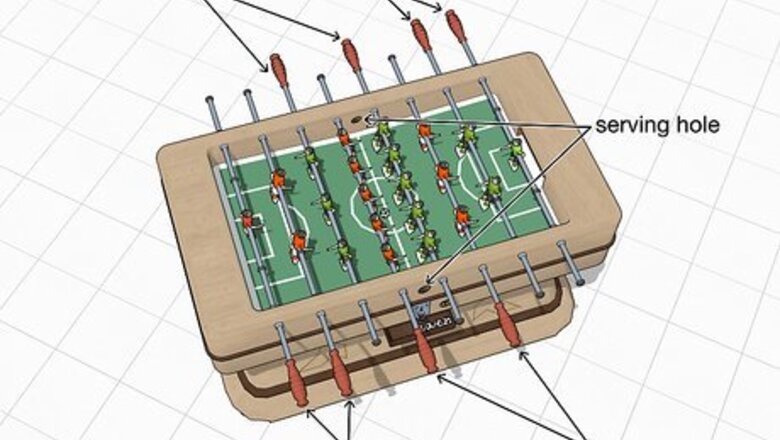
views
Understanding the Rules and Gameplay
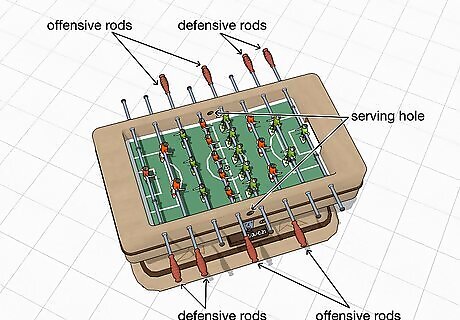
Review the different parts of the table. Note that the table looks like a mini soccer field, with 8 rods going across the field. These are labeled based on the number of mini “players” on each rod. Each team has 2 offensive rods, known as a 5-rod and a 3-rod, along with 2 defensive rods, known as the 2-rod and goalie-rod. Along the sides of the table, you can find a serving hole where the ball goes to start the game. Once the ball enters the goal, it rolls into the table’s cabinet. There are slots or openings along the sides of the table where you can find and reuse the scored balls.
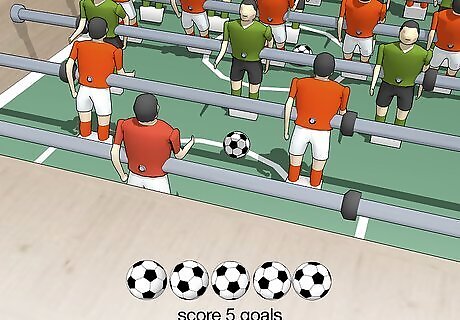
Plan to score 5 goals before your opponent does. As the game name suggests, table football is very similar to a real game of football, or soccer. You use both hands to maneuver the rods and control your “players,” which kick and pass the ball along the table. Like in a real game of football, your goal is to kick the ball past the goalie and score a point for your team. Once you score 5 goals, you’ve won the game! You can set your own custom game terms, too. If you’re playing a quick match, the first person to 1-2 goals can be the winner.
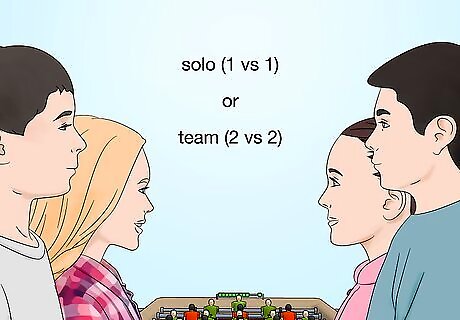
Decide if you want to play solo or with a team. You control all 4 rods if you play by yourself, or you can divide your team’s rods up among other players. In this format, 1 player will control the offensive 3-rod and 5-rod, while the other player will control the defensive 2-rod and goalie-rod. You can also divide up the rods between 3 or 4 people, depending on how you want to play. When you play with multiple people, you can only control your assigned rod, as no switching is allowed during the game.
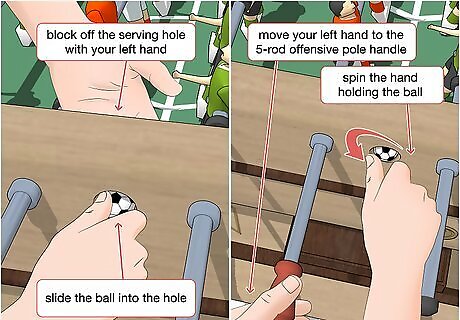
Serve the ball so gameplay can begin. Block off the serving hole with your left hand, then slide the ball into the hole. Lift your left hand away from the covering and move it to the handle of the 5-rod offensive pole. At this point, spin the hand holding the ball so the ball lands on your side of the table. You can flip a coin to decide who gets to serve first.
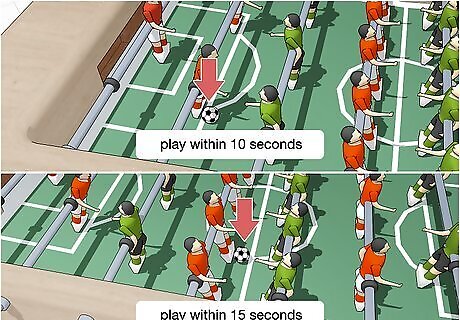
Make your plays within 10-15 seconds of getting the ball. Keep a mental clock going in your head as you play the game. Countdown from 10 as soon as 5-rod receives the ball. If your 3-rod, 2-rod, or goalie rod gets the ball, you have 15 seconds to make a play. If you don’t play the ball within 10 seconds, the play is reset and your opponent gets to serve.
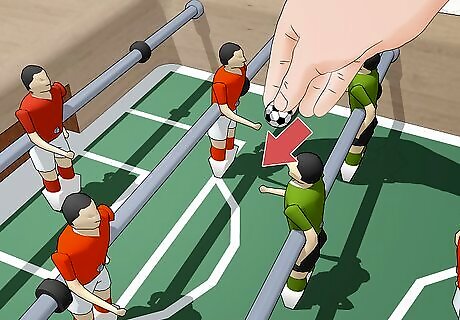
Reset the ball when it’s “dead.” Grab the ball if it flies off the table. Place the ball near the server’s 2-rod so they can restart the game again. If the ball rolls into a dead zone near the goalie, move it to the nearest corner. If the ball becomes dead on another part of the table, you can place the ball in front of the original server for the round. The ball goes to the opponent of whoever kicked the ball off the table or forced it into a dead zone. If the ball is spinning, it isn’t dead.
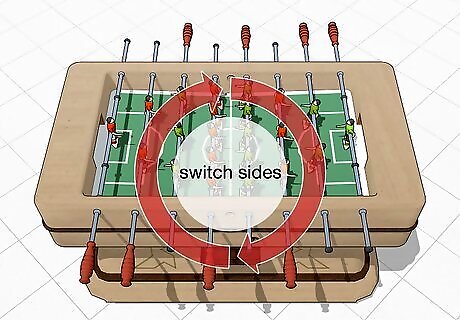
Switch sides after each game if you’re playing multiple games. Play through your first match of foosball until 1 team scores 5 points. At this point, switch sides so that you’re using the bars and players on the opposite side of the table. You have 60 seconds to make the switch, or else you’ll be penalized for slowing the game down. You can penalize someone by letting the other team serve first, or by choosing another similar punishment.
Playing Offense
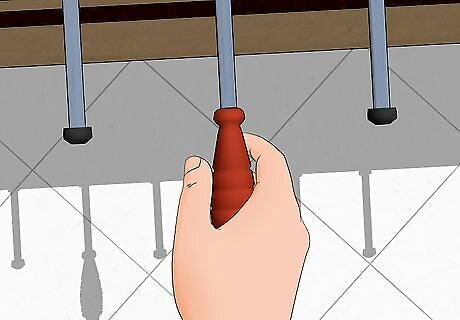
Wrap your hand around the handle without your thumb and fingers touching. Try not to squeeze or grip the handle too much—instead, wrap your hand around gently, with your palm on top of the handle and your thumb and fingers on opposite sides of 1 another. Grip the handles in this fashion so you can make sturdy, stable plays. Try not to keep your thumb on top of the handle, or else you won’t have a lot of control over your swings. You don’t want to have white knuckles while you play.
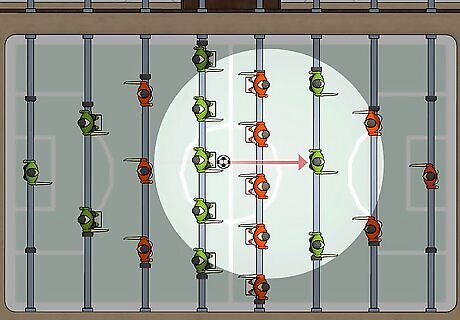
Space out your playing bars so you can make clearer shots. Keep your 2 offensive playing rods spaced out, leaving an ample gap for passing and serving successfully. Keep your players lined up so you can pass the ball cleanly and neatly, which lets you make more effective shots on the goal. Try to stagger your offensive players so they’re spaced between your opponent’s defensive players.
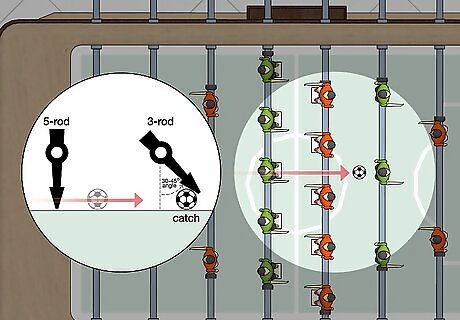
Pass the ball to your 3-rod row of players. Secure the ball beneath your 5-rod pole after your serve. Rotate the pole so the player’s foot is at a 90-degree angle behind the ball. Move the player forward to “kick” the ball, but continue to swing the player upwards to follow through with the kick. With your 3-rod row, “receive” the pass by holding your 3-rod player at a 30 to 45-degree angle behind the ball. Similar to real football or soccer, passing is a valuable strategy that can help you keep the ball moving.
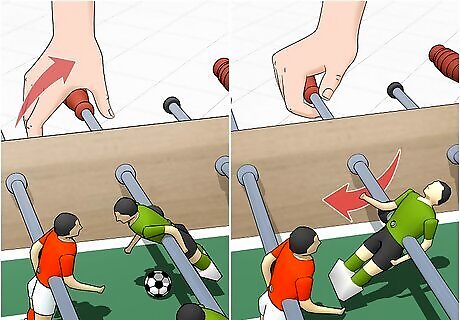
Try an open-handed grip when making offensive shots. Loosen your grip, leaving the bottom of your palm and the top of your wrist touching the handle. Slide your wrist and hand up to create a powerful offensive kick. Try to flick your wrist as you do this, so your movements can be as fluid as possible. Avoid spinning the rod in a full circle, as this is illegal.
Playing Defense
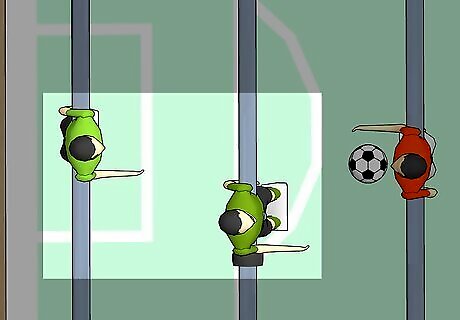
Combine your defensive rods to make more effective plays. Slide your defensive bar so your goalie and 1 of your defenders are shoulder-to-shoulder. Keep these players close together so your opponent doesn’t have as many clear opportunities to shoot on your goal. The ball shouldn’t be able to pass through your goalie or your defender.
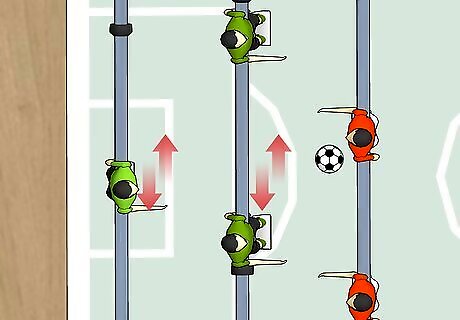
Block your opponent’s plays with your 2 defensive rods. Slide and rotate your 2 rods that are closest to your goal, which will help you block and defend your goal. Keep an eye on the ball and slide your defenders and goalie accordingly so the ball stays away from your goal. While the goalie and defending bars can be used to score, they’re usually used to defend and clear out the ball.
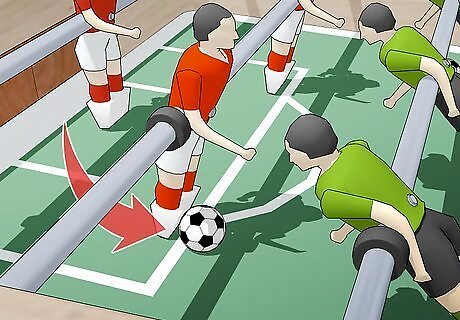
Clear the ball from your goal with 1 of your defensive bars. Put a lot of power into your “kick” when the ball ends up in your defensive area. Pause the ball with your player before passing or kicking it forward. If you send a rolling ball towards your opponent, you may give them a free shot on your goal. The main focus of clearing the ball is keeping your goal safe, not collecting points.
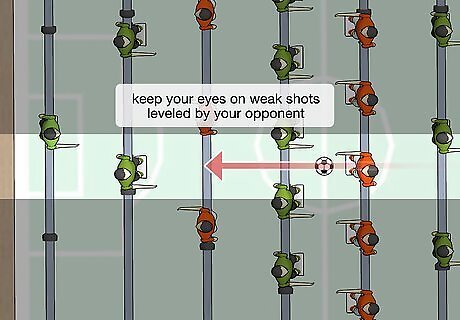
Deflect bad shots from your opponent into their goal. Keep your eyes peeled for weak shots leveled by your opponent, which leaves the ball rolling toward your players. Take these opportunities to kick the ball with your own players. Depending on the set-up, you may be able to turn your opponent’s bad play into an unlikely goal!












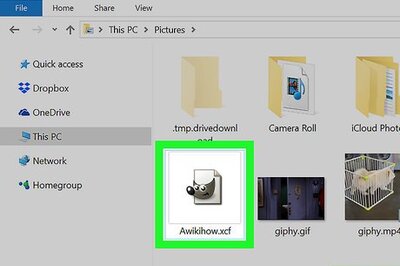






Comments
0 comment